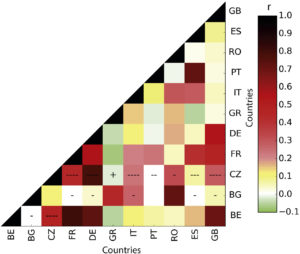Published in Renewable Energy, Volume 163, 674–684, 2021:
The increasing use of wind and solar power requires interventions to balance the associated variability in energy production. One option to reduce the costly interventions is to exploit the natural de-correlation of wind and irradiance. This study characterises the balancing potential of the natual variability in wind and photovoltaic energy production within and across eleven European countries. We use 20 years of highly resolved meteorological data from a post-processed regional reanalysis with a 6 km horizontal grid to calculate daily photovoltaic and wind power. Our results suggest a country-dependent reduction of the day-to-day variability in energy production by 29%–42% due to installing both PV and wind power capacities, compared to wind power only. The optimized photovoltaic to photovoltaic plus wind power generation ratios are 45–57% for maximizing balancing effects associated with the changing weather. We further identify on less than 10% of the days a simultaneous occurrence of extremes in photovoltaic and wind power across European countries. The cross-border balancing potentials for the extremes in renewable energy production are therefore high due to the spatio-temporal differences of the local weather.
ChristopherFrank, StephanieFiedler and Susanne Crewell

